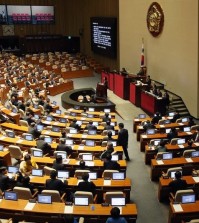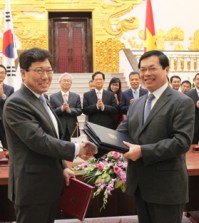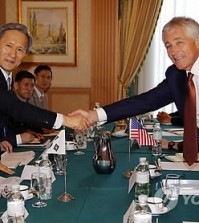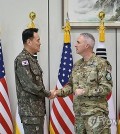- California Assembly OKs highest minimum wage in nation
- S. Korea unveils first graphic cigarette warnings
- US joins with South Korea, Japan in bid to deter North Korea
- LPGA golfer Chun In-gee finally back in action
- S. Korea won’t be top seed in final World Cup qualification round
- US men’s soccer misses 2nd straight Olympics
- US back on track in qualifying with 4-0 win over Guatemala
- High-intensity workout injuries spawn cottage industry
- CDC expands range of Zika mosquitoes into parts of Northeast
- Who knew? ‘The Walking Dead’ is helping families connect
FTA boosts Korea’s exports to U.S.
Two-year review shows US gain in services sector
By Yoon Ja-young
Korea has seen its exports to the United States soar in the two years since the Korea-U.S. Free Trade Agreement (FTA) came into effect, according to a report released by the government Friday.
The U.S., meanwhile, is winning in the services sector. Experts point out that Korea should get rid of hidden barriers so consumers can fully enjoy the benefits of the FTA, which became effective on March 15, 2012.
According to data released by the Ministry of Trade, Industry and Energy, Korea’s exports to the U.S. grew by 10.3 percent, while overall exports grew by 6 percent.
“Since the FTA took effect, Korea’s exports to the United States grew faster than its total exports, becoming a sustaining pillar for exporters,” the ministry said. The world’s biggest market takes 22.5 percent of the global GDP.
The U.S. is currently Korea’s third-largest trade partner, with $103.5 billion in trade volume, following China and the E.U.
Total imports of U.S. goods decreased by 3.8 percent, but those of products that benefited under the pact jumped 10.1 percent.
When talks of the free trade negotiations started, the biggest concern was Korea’s fragile agriculture sector.
Statistics show, however, that exports of Korea’s agricultural products and food expanded by 21.4 percent during the past two years, while imports fell by 20.2 percent. The ministry explained that the import of U.S. grain decreased due to a drought in North America.
Some fresh fruits, however, are increasing their market share. Korea is importing 92.4 percent more cherries from the compared with two years ago, and 93 percent more grapes.
The pact also boosted U.S. investment in Korea, which has nearly doubled during the two-year period to 24.5 percent of the total foreign direct investment (FDI) as of the end of the last year.
“U.S. money is contributing to the advancement of the domestic industry, heading to diverse sectors such as green-field investment and services,” the ministry said. Green-field investment refers to FDI to build new factories and thus create jobs.
The automobile industry is benefiting from the FTA in both Korea and the U.S. Korea’s automobile exports increased by around 200,000 vehicles, to hit 759,385 last year, compared with 2011.
U.S. automakers are also expanding their share in the Korean market, nearly doubling during the two-year period _ its market share grew 9 percent, while that of the E.U. dropped 1 percent.
Kim Hyung-joo, a research fellow at LG Economic Research Institute, said that exports to the U.S. grew thanks to both the FTA and the economic recovery there.
“The effects of the two are mixed in the statistics. Exports to the E.U. meanwhile decreased despite the Korea-E.U. FTA due to the sluggish economy in Europe,” he explained, adding that it will take more years to analyze the effect of that trade deal.
US reaction
Some NGOs and unions in the U.S., however, are complaining over the trade deficit with Korea since the signing of the pact. The United Steelworkers said the FTA fell far short regarding jobs promised, and pointed out that the monthly trade deficit with Korea has ballooned 45 percent. It added that the deal caused the loss of tens of thousands of manufacturing jobs.
Tami Overby, vice president for Asia at the U.S. Chamber of Commerce, however, said in a lecture organized by the Korea Society in New York, that though exports to Korea decreased, people one shouldn’t evaluate the FTA only on exports, explaining that the U.S. has succeeded in the services sector. She called the FTA a win-win situation.
Overby added that she expects Korea to join in the Trans-Pacific Partnership (TPP) pact after solving problems with the Korea-U.S. FTA. She pointed to non-customs barriers and automobile as the problems.
Regarding complaints by some NGOs about the trade deficit, Kim said, “It depends on the industry, but the U.S. doesn’t have a competitive edge over Korea in manufacturing. It has competitiveness in the agricultural sector and services.”
Washington started talks on the FTA as it expected to gain in these sectors, but due to bad weather there last year, exports were not good, he said. “In the case of services, legal and accounting services will come into full effect after a few years,” he said, explaining that the U.S. will have more to gain in these sectors.
Consumers doubting benefits
Consumers, however, complain that they don’t seem to be benefiting from the FTA. They expected agricultural goods to become cheaper, but some of them have become more expensive. The prices of oranges, for instance, rose by 1,276 won per kilogram over the past two years, and beef also soared to 8,154 won per kilogram.
Kim said that is due to internal barriers.
“Many of the products are brought into the country by exclusive importers. Even if the government is expanding parallel imports, the distributors take away the benefits of the FTA. Though the pact is supposed to pull down the prices by 5 to 10 percent, for instance, the benefits are gone before they reach consumers,” he said.
He added the government should focus on getting rid of the internal barriers. “The FTA aims at making the economy more liberal and effective. To maximize its effect, you should get rid of the unnecessary hurdles and regulations within the market.”















